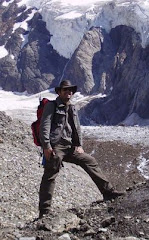Most extensive cavity networks occur in water soluble lithology, like carbonatic or evaporitic formations, but smaller fissures and gorges can develop also by mechanical erosion or physical degradation of the underground, for example melting of ice (thermokarst).
Fissures can gather animals’ remains over a certain time interval simply by animals falling and/or remaining entrapped inside, and being otherwise inaccessible the bones are also protected from scavengers.
An important site of this type is represented by Pirro Nord, situated in a quarry at the north-western margin of the Gargano promontory, close to the village of Apricena in the italian province Apulia.

Here in sediments filling an extensive karst network, discovered during quarrying of limestone, a very diverse and now well-documented fossil vertebrate assemblage was discovered. This sediments returned also lithic artifacts, estimated in an interval between 1,3 and 1,7 Ma, documenting an early hominin occurrence in the older part of the Early Pleistocene, and thus now constitute the oldest record in Europe.
The karst network developed during two phases. The first, Miocene in age, extents in the mesozoic limestone of the „Sannicandro Formation“ (Cretaceous), and consists of red clays (terra rossa) in part reworked and redeposited with a hughe diversity of vertebrates remains assigned to the „Mikrotia-Fauna“, after a an endemic rodent genus.
The second phase of karst development occurred after a tectonic uplift of the Gargano peninsula during the Pliocene, extending in formerly deposited Pliocene sediments and protruding in the Sannicandro Formation. Fissures can also show in the lower part fossils attributed to the Mikrotia – Fauna, and in the upper parts of the Villafranchian mammal age (Upper Pliocene and Lower Pleistocene, 3.6–1.2 Ma ago).
 The stratigraphic succession of the Apricena horst in the „Cava Passalacqua”, as seen in the vast quarry dominating the landscape near Apricena. In the lower part the quarried Mesozoic limestone’s of the “Sannicandro Formation”, truncated by Miocene red clays and karst infillings of the “Terre rosse”, covered by the yellow Pliocene deposits of the “Lago di Varano Formation” and finally sandstones of the “Serracapriola Formation”.
The stratigraphic succession of the Apricena horst in the „Cava Passalacqua”, as seen in the vast quarry dominating the landscape near Apricena. In the lower part the quarried Mesozoic limestone’s of the “Sannicandro Formation”, truncated by Miocene red clays and karst infillings of the “Terre rosse”, covered by the yellow Pliocene deposits of the “Lago di Varano Formation” and finally sandstones of the “Serracapriola Formation”. Detail of the “Sannicandro Formation” with extensive karst network development.
Detail of the “Sannicandro Formation” with extensive karst network development. Balanus sp. occurrence in the Pliocene cover units.
Balanus sp. occurrence in the Pliocene cover units.The accumulation of large mammals has been due the infall or entrapment of carcasses within the wider cavities, and by subsequent transport within the karst network when it was flooded. The occurrence of a number of articulated skeletons is suggestive of accumulation of carcasses also without transport.
 Karst fissure with extensive infill of red, sandy clays - "Terra Rossa", and also bones:
Karst fissure with extensive infill of red, sandy clays - "Terra Rossa", and also bones:
 A teeth of Deinogaleryx, an giant hedgehog...
A teeth of Deinogaleryx, an giant hedgehog... ...and Hoplitomeryx, an endemic Miocene artiodactyl.
...and Hoplitomeryx, an endemic Miocene artiodactyl.The abundance of bones and coprolites of Pachycrocuta brevirostris, as well as the occurrence of numerous gnawing and bite marks on fossil bones, suggests that this giant hyaenid species played an important role in local bone accumulation.
The Pirro Nord fauna mammal fauna is uncommonly diverse, until now 20 species of amphibians and reptiles, 47 species of birds and over 40 mammal species were described, some of them though to be endemic to the Gargano.
The nature of the landscape of the „catchment area“ of the ancient caves 2 Ma ago can be inferred from the composition of it´s vertebrate assemblage. The occurrence of perissodactyls, cheetah, large sized porcupine, abundant vole of the genus Allophaiomys and presence of bird species of the families Otidae, Pteroclidae and Alaudidae are all suggestive of open landscape with a basically arid climate.
 Mandible with teeth from a Pleistocene bat.
Mandible with teeth from a Pleistocene bat.References:
ARZARELLO et al. (2007): Evidence of earliest human occurrence in Europe: the site of Pirro Nord (Southern Italy). Naturwissenschaften 94: 107-112
PAVIA & ZUNINO (2009): Giornate di paleontologia IX edizione Apricena (FG), 28-31 Maggio 2009 – Guida alle escursioni 30 e 31 maggio 2009.
See part II
ARZARELLO et al. (2007): Evidence of earliest human occurrence in Europe: the site of Pirro Nord (Southern Italy). Naturwissenschaften 94: 107-112
PAVIA & ZUNINO (2009): Giornate di paleontologia IX edizione Apricena (FG), 28-31 Maggio 2009 – Guida alle escursioni 30 e 31 maggio 2009.
See part II





Keine Kommentare:
Kommentar veröffentlichen